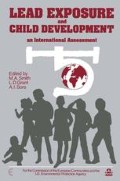Summary
Blood lead concentration (PbB) and erythrocytic protoporphyrin concentration (EP) are both used as indices of lead exposure in children and in occupationally exposed adults. In a previous study we reported dose- effect and dose-response relationships, in EP vs. PbB (Hammond et al, 1985). In the present study we report the influence of age on the threshold for an EP response to PbB, as well as on the slope of the dose-effect interaction. In the age range 12–30 months the threshold for effect of PbB on EP falls progressively, while the magnitude of the dose-effect increases with age. The rate of decline in the threshold for In EP and the rate of increase for ln EP·PbB-1 are linearly related to age.
Access this chapter
Tax calculation will be finalised at checkout
Purchases are for personal use only
Preview
Unable to display preview. Download preview PDF.
References
Bellinger, P., Leviton, A., Needleman, H.L., Waternaux, C. and Rabinowitz, M. (1986) Low- level lead exposure and infant development in the first year. Neurobehav. Toxicol. Teratol., 8, 151–161
Chisolm, J.J. and Brown, P. (1975) Micro-scale photofluorometric determination of free erythrocyte porphyrin (protoporphyrin IX). Clin. Chem., 21, 1669–1682
Dietrich, K.N., Krafft, K.M., Shukla, R., Bornschein, R.L. and Succop, P.A. (1986) The neurobehavioral effects of prenatal and early postnatal lead exposure. In Schroeder, S.R. (ed.), Toxic Substances and Mental Retardation: Neurobehavioral Toxicology and Teratology ( Washington, DC: AAMD Monograph Series )
Hammond, P.B., Lerner, S.J., Gartside, P.S., Hanenson, J.B., Roda, S.B., Foulkes, E.C., Johnson, D.R. and Pesce, A.J. (1980). The relationship of biological indices of lead exposure to the health status of workers in a secondary lead smelter. J. Occup. Med., 22, 475–484
Hammond, P.B., Bornschein, R.L. and Succop, P. (1985) Dose-effect and dose-response relationships of blood lead to erythrocytic protoporphyrin in young children. Environ. Res., 38, 187–196
Lamola, A.A., Joselow, M. and Yamane, T. (1975) Zinc protoporphyrin (ZPp): a simple, sensitive fluorometric screening test for lead poisoning. Clin. Chem., 21, 93–97
Lilis, R., Fischbein, A., Diamond, S., Anderson, H.A., Selikoff, J.J., Blumberg and W.E., Eisinger, J. (1977) Lead effects among secondary lead smelter workers with blood lead levels below 80 µg/100 ml. Arch. Environ. Health, 32, 256–266
NAS-NRC (1972) Airborne Lead in Perspective ( Washington, DC: National Academy of Sciences )
Piomelli, S., Seaman, C., Zullow, D., Curran, A. and Davidow, B. (1982) Threshold for lead damage in heme synthesis in urban children. Proc. Natl. Acad. Sci. USA, 79, 3335–3339
Raghavan, S.R.V., Culver, B.D. and Gonick, H.C. (1981) Erythrocyte lead-binding protein after occupational exposure. II. Influence on lead inhibition of membrane Na+,K+- adenosinetriphosphatase. J. Toxicol. Environ. Health, 7, 561–568
Spivey, G.H., Brown, C.P., Baloh, R.W., Campion, D.S., Valentine, J.L., Massey, F.J., Browdy, B.L. and Culver, B.P. (1979) Subclinical effects of chronic increased lead absorption - a prospective study. 1. Study design and analysis of symptoms. J. Occup. Med., 21, 423–429
Valciukas, J.A., Lilis, R., Eisinger,J., Blumberg, W.E., Fischbein, A. and Selikoff, FJ. (1978) Behavioral indicators of lead neurotoxicity: results of a clinical field survey. Int. Arch. Occup. Environ. Health, 41, 217–236
Editor information
Editors and Affiliations
Rights and permissions
Copyright information
© 1989 ECSC-EEC-EAEC, Brussels — Luxembourg; EPA, USA
About this chapter
Cite this chapter
Succop, P.A., Hammond, P.B., Bornschein, R.L., Roda, S.B., Greenland, R.D. (1989). Recent Observations Concerning the Relationship of Blood Lead to Erythrocytic Protoporphyrin. In: Smith, M.A., Grant, L.D., Sors, A.I. (eds) Lead Exposure and Child Development. Springer, Dordrecht. https://doi.org/10.1007/978-94-009-0847-5_33
Download citation
DOI: https://doi.org/10.1007/978-94-009-0847-5_33
Publisher Name: Springer, Dordrecht
Print ISBN: 978-94-010-6868-0
Online ISBN: 978-94-009-0847-5
eBook Packages: Springer Book Archive

